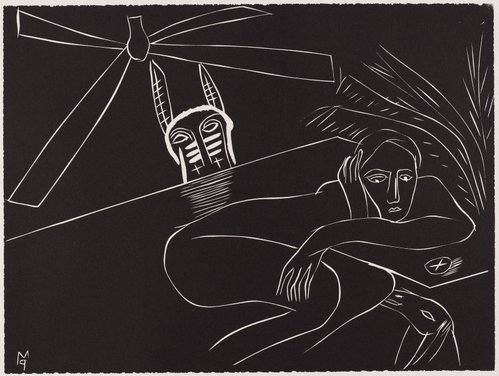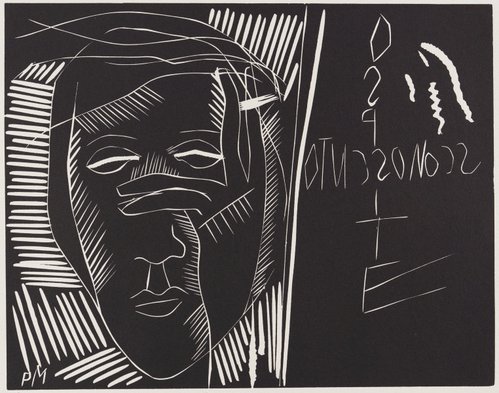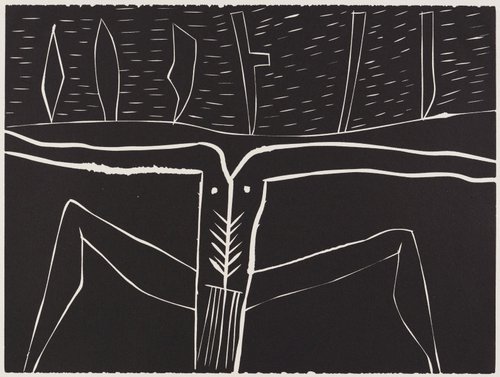

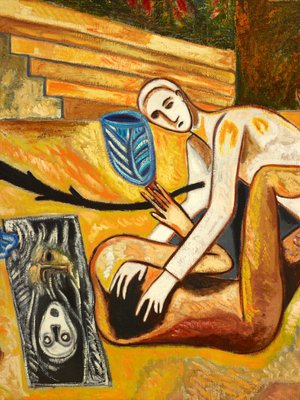

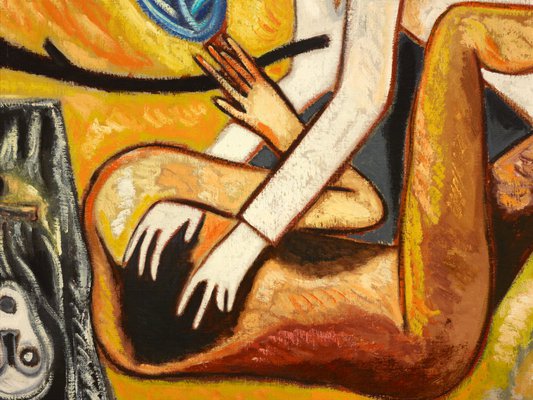


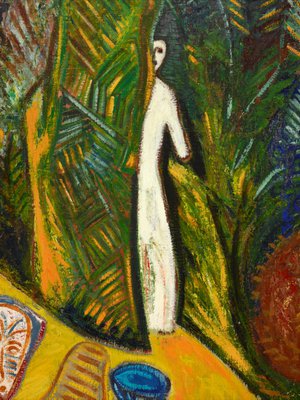

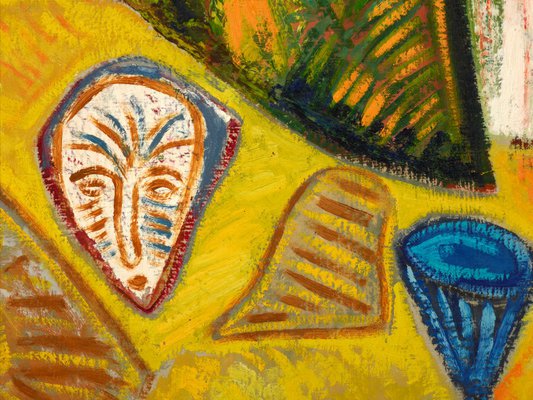
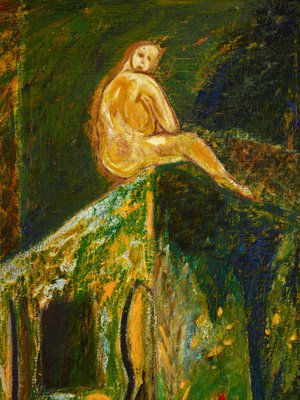

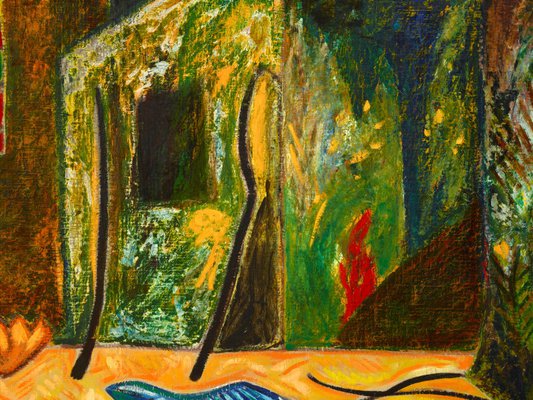
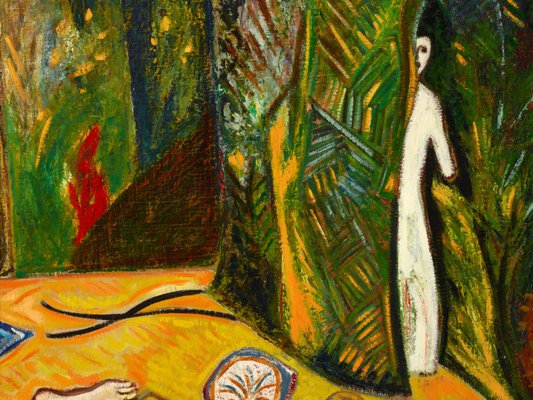
-
Details
- Date
- 1984
- Media category
- Painting
- Materials used
- oil on canvas
- Dimensions
- 300.0 x 400.0 cm
- Signature & date
Signed and dated c. verso, black oil "M. Paladino/ 1984".
- Credit
- Mervyn Horton Bequest Fund 1987
- Location
- Not on display
- Accession number
- 467.1987
- Copyright
- © Mimmo Paladino
- Artist information
-
Mimmo Paladino
Works in the collection
- Share
-
-
About
Having experimented early with conceptual art, Mimmo Paladino moved rapidly into developing an allegorical figurative style drawing upon mythological, classical, tribal and Christian imagery. By 1981 he was recognised as a leading international artist after a major solo exhibition at the Kunstmuseum Basel, which travelled through Germany, and his participation in the ‘New spirit of painting’ exhibition at the Royal Academy of Arts in London that marked the beginning of neo-expressionism. Mythology for Paladino is more than ancient tales; rather it refers to the fight between the artist and the surface of the painting in which problems, questions and the mysteries of painting are played out. He incorporates imagery that is allegorical and often drawn from memory or classical myths that are painted in a primitive vocabulary with stylised skeletal bodies influenced by Etruscan and ancient Roman art. The motifs he employs include masks that are overlaid with archaic markings – vessels, steps, crosses and leaf forms. Painted directly onto the canvas, the works also remain untitled until they are finished, reinforcing Paladino’s claim that the adventure of painting is in allowing his mythological sources and imagery to work through the paint.
The scene for ‘Cordoba’ resembles a theatrical installation or setting for the event that is taking place. At centre stage two figures grapple; one dominates the fight while the other reaches for a branch-like weapon in defence. Around them various masks, pictures and cups are disturbed and onlookers peer over their shoulders and from behind trees. The figures are haunting, expressionless, and although active seem limited in their ability to act within the event. The face of one of the fighters morphs with a mask that suggests deception and untruth or screaming, echoing Munch’s ‘The scream’. The biomorphic forms in the background allude to a city overgrown by flora, a lost city, a return to nature. It is clear that we are merely onlookers and not part of the action; instead we join those in the wings who passively observe the violence.
The title could refer to the city Cordoba in Spain or Argentina, or similarly to the explorer Francisco Fernandez de Cordoba. Paladino however refers to ‘Cordoba’ as a struggle between two people or perhaps a dance, preferring to keep the interpretation open. The ambiguous nature of his imagery creates a deliberate paradox in which no single formula is evident, and every work has multiple interpretations and definitions, as arcane motifs and modern mark-making collide.
© Art Gallery of New South Wales Contemporary Collection Handbook, 2006
-
Exhibition history
Shown in 4 exhibitions
Mimmo Paladino: Paintings, Sculptures, Mosaics, Waddington Galleries, London, 03 Oct 1984–27 Oct 1984
The European Iceberg: Creativity in Germany and Italy Today, Art Gallery of Ontario, Canada, 08 Feb 1985–07 Apr 1985
Mimmo Paladino, Städtische Galerie im Lenbachhaus, Munich, Germany, Jul 1985–Aug 1985
Some mysterious process, Art Gallery of New South Wales, Sydney, 01 Jun 2020–13 Sep 2020
-
Bibliography
Referenced in 7 publications
-
Art Gallery of Ontario, The European Iceberg: creativity in Germany and Italy today, Toronto, circa 1985, 146 (illus.).
-
Anthony Bond, Art Gallery of New South Wales handbook, 'Contemporary', pg. 94-108, Sydney, 1988, 95, 96 (illus.).
-
Donna Brett, Contemporary: Art Gallery of New South Wales Contemporary Collection, 'Expression and the figure', pg.108-153, Sydney, 2006, 144, 145 (colour illus.).
-
Städtische Galerie im Lenbachhaus, Munich, Mimmo Paladino, Munich, 1985, 83 (illus.). cat.no. 47
-
Waddington Galleries, Mimmo Paladino, London, 1984, 33-35 (colour illus.). cat.no. 19, illustrations on pages 34-35 are details
-
Michael Wardell, Look, 'Mervyn Horton's bequest', pg. 11-12, Sydney, Jun 2004, 12.
-
Donald Williams and Colin Simpson, Art now: contemporary art post - 1970, Sydney, 1994, 206 (colour illus.). Fig. 11.14
-


